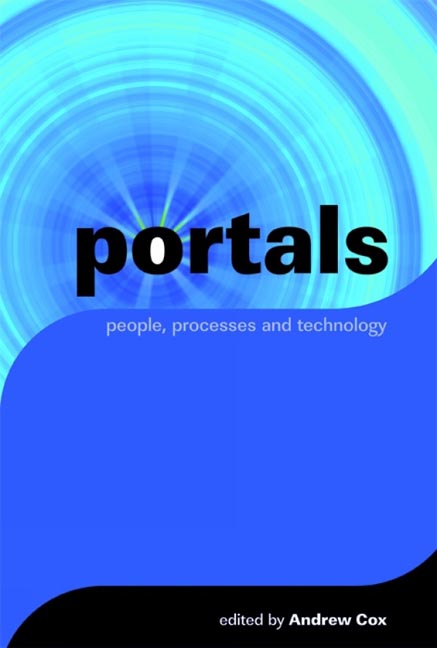Book contents
- Frontmatter
- Contents
- Introductory preface
- Section 1 Core themes
- 1 Definitions and debates
- 2 Portals or filters? Identifying quality on the internet
- 3 Portal architectures
- 4 Personalization initiatives in the public and academic domains
- 5 User needs analysis and evaluation of portals
- 6 Managing portal services
- Section 2 The library and the portal
- Section 3 The portal in the corporate sector
- Section 4 Portals in the public sector
- Section 5 The future
- The contributors
- Index
4 - Personalization initiatives in the public and academic domains
from Section 1 - Core themes
Published online by Cambridge University Press: 09 June 2018
- Frontmatter
- Contents
- Introductory preface
- Section 1 Core themes
- 1 Definitions and debates
- 2 Portals or filters? Identifying quality on the internet
- 3 Portal architectures
- 4 Personalization initiatives in the public and academic domains
- 5 User needs analysis and evaluation of portals
- 6 Managing portal services
- Section 2 The library and the portal
- Section 3 The portal in the corporate sector
- Section 4 Portals in the public sector
- Section 5 The future
- The contributors
- Index
Summary
Introduction
To personalize has been defined as to ‘design or produce (something) to meet someone's individual requirements’. That products and services should be focused on a target community and fulfil the demands, wants and needs of that community is accepted as a truism by marketers in virtually all domains. A successful product, whether it is a car seat, a bar of chocolate or a computer game, tends to be inspired by a deep knowledge of the consumer derived either through systematic market research or expert knowledge via practice. Such products tend to satisfy either a long, thin horizontal niche across a wide population or a deep, narrow niche vertically within a population. Information products and services, although paying lip service to user-centred design, have tended not to be geared to the specific needs of the user. However, current developments in personalization are beginning to lead to information products that can be both generic and specific by being able to adapt to the specific needs of the user.
In the past this ‘consumerist market philosophy’ has only partially penetrated the design and development of information products. Services such as portals as well as libraries, compact discs, online databases, public access catalogues, portals, web-based information services, even the computer desktop itself and most computer applications have tended to be generalized and aimed to meet the common needs of a broad community.
In fact there is still doubt in some quarters about the general value of investing time on personalization. Neilsen (1998), for example, who has gained quite a reputation in the area of human–computer interface design and usability, has stated that it is better to concentrate on general characteristics of good interface design than on personalization. Despite the stress on personalization features in an increasing number of products – portals, online catalogues, virtual learning environments, world wide web search tools, e-messaging services, as well as by e-commerce vendors – few studies have been conducted into the impact of personalization. One exception is in personalized health information provision where Kreuter and Strecher (1996) showed the benefit of personalized information provision. Whether or not this has similar lessons for information products that serve a less focused need is as yet unproven.
- Type
- Chapter
- Information
- Portalspeople, processes and technology, pp. 38 - 51Publisher: FacetPrint publication year: 2006



